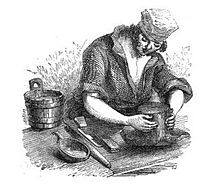William Miller Christy

William Miller Christy (1778–1858) was an English Quaker hat and textile manufacturer, known also as a banker. He is credited with the invention of the penny receipt-stamp.[1]
Life[edit]
He was the second son of Miller Christy (1748–1820) and Ann Rist.[2] The Christy family had a hat-making business at 35 Gracechurch Street, and Christy himself was apprenticed to a hatter.[3]

The firm developed manufacturing interests in Bermondsey and Stockport, and Christy was a founder of the London Joint Stock Bank.[4] In 1824 he was a founder of Christy, Lloyd & Co, the Stockport and East Cheshire Bank, with Isaac Lloyd and two other partners. The immediate challenge of the panic of 1825 was handled with the support of Hanbury & Co., the bank's London associates.[5]
The bank was sold in 1829, and Christy acquired capital, with which he entered the cotton business, in Stockport and then Droylsden. The enterprise later made a major success of the Christy towel.[3] In 1841 the Christy Bermondsey works was reputedly the largest manufacturer of hats in the world and had 500 employees;[6][7] silk coverings for hats were made in Stockport, and the factory there had more workers.[8] The business dropped off later in the century, as the beaver hat went out of style.[9]
Family[edit]

Miller married Ann Fell, and they had seven sons and three daughters. The second son was Henry Christy.[2]
Notes[edit]
- ^ Henry Woodward (1865). Geological Magazine. Cambridge University Press. p. 286.
- ^ a b Sir Bernard Burke (1852). A genealogical and heraldic dictionary of the landed gentry of Great Britain & Ireland for 1852. Colburn and Company. p. 220.
- ^ a b ELGAR: Electronic Gateway to Archives at Rylands, Papers of W. M. Christy & Sons Ltd
- ^ The Gentleman's Magazine and Historical Review. J. H. and J. Parker. 1865. p. 514.
- ^ Humphrey Lloyd (November 2005). The Quaker Lloyds in the Industrial Revolution. Taylor & Francis. pp. 285–6. ISBN 978-0-415-38161-1.
- ^ G. W. Phillips (1841). The History and Antiquities of the parish of Bermondsey. J. Unwin. p. 105.
- ^ Roy Porter (5 October 2000). London: A Social History. Penguin Adult. p. 309. ISBN 978-0-14-010593-3.
- ^ Edward Wedlake Brayley; John Britton (1841). A Topographical History of Surrey. pp. 451–.
- ^ Francis Henry Wollaston Sheppard (1 January 1971). London, 1808-1870: The Infernal Wen. University of California Press. p. 161. ISBN 978-0-520-01847-1.
